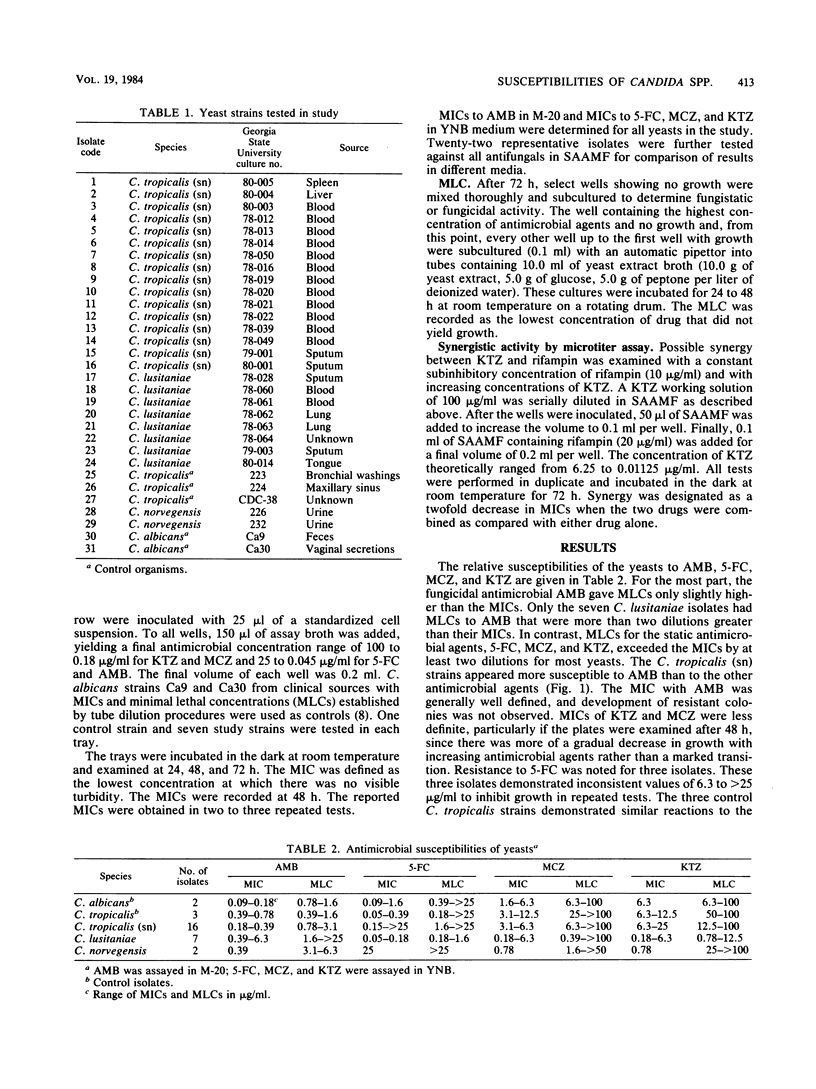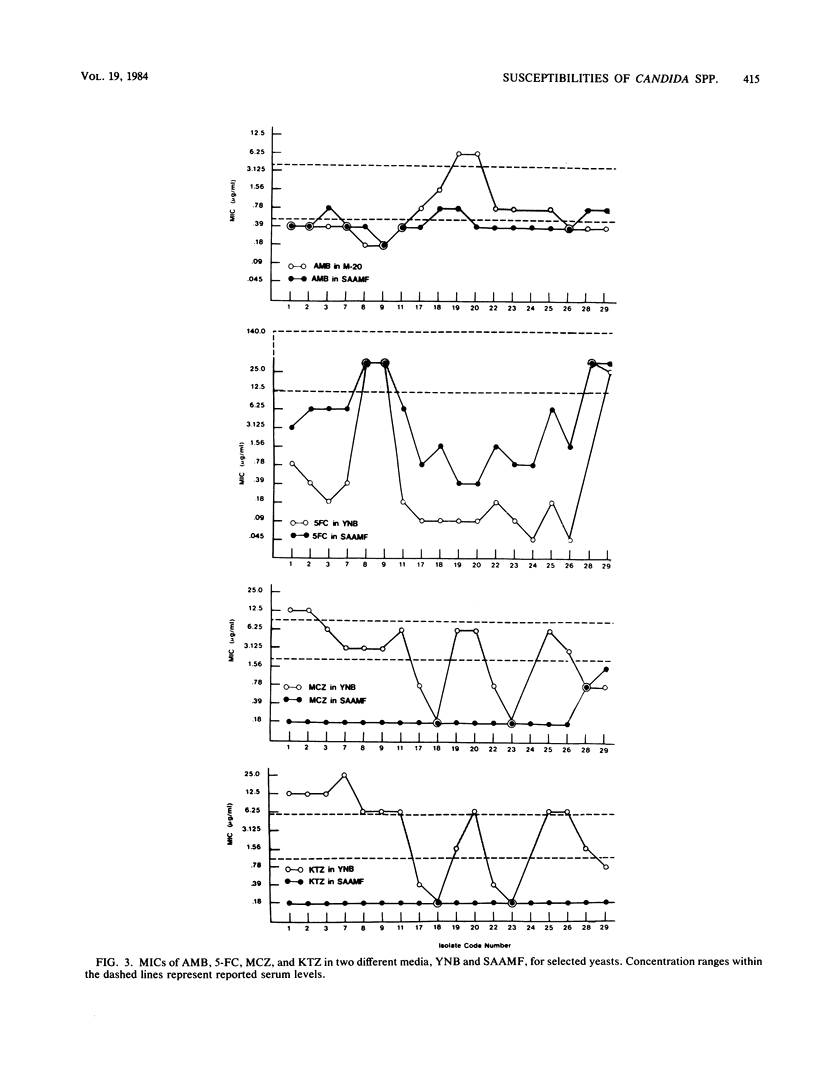Abstract
The MICs and minimal lethal concentrations of four antimycotics, amphotericin B, 5-fluorocytosine, miconazole nitrate, and ketoconazole, were determined for 25 yeast isolates representing species uncommonly implicated in candidiasis. A microdilution procedure was employed with complex and synthetic media. The isolates, in general, were susceptible to the same antimicrobial agents shown to be effective against Candida albicans, but differences between some of the species in relative susceptibilities to the antifungal agents were noted. Isolates of atypical sucrose-negative Candida tropicalis were similar in their susceptibility patterns to typical isolates of the species. Relative resistance to amphotericin B, miconazole nitrate, and ketoconazole was noted for two Candida lusitaniae isolates, but all strains were susceptible to 5-fluorocytosine. Candida norvegensis isolates were more resistant to miconazole and ketoconazole than C. albicans clinical isolates. The microtiter system was satisfactory for determining minimal inhibitory concentrations, but the system is not recommended for detecting finite differences in drug susceptibilities or for detecting drug synergism.
Full text
PDF




Selected References
These references are in PubMed. This may not be the complete list of references from this article.
- Ahearn D. G., Meyer S. A., Mitchell G., Nicholson M. A., Ibrahim A. I. Sucrose-negative variants of Candida tropicalis. J Clin Microbiol. 1977 Apr;5(4):494–496. doi: 10.1128/jcm.5.4.494-496.1977. [DOI] [PMC free article] [PubMed] [Google Scholar]
- Baker J. G., Salkin I. F., Pincus D. H., D'Amato R. F. Diagnostic characters of an atypical Candida. J Clin Microbiol. 1981 Jan;13(1):199–203. doi: 10.1128/jcm.13.1.199-203.1981. [DOI] [PMC free article] [PubMed] [Google Scholar]
- Ellis N. S., Bartlett M. S., Smith J. W. Assay for yeast susceptibility to 5-fluorocytosine and amphotericin B in a frozen microtiter system. Am J Clin Pathol. 1979 Aug;72(2):194–198. doi: 10.1093/ajcp/72.2.194. [DOI] [PubMed] [Google Scholar]
- Hoeprich P. D., Huston A. C. Effect of culture media on the antifungal activity of miconazole and amphotericin B methyl ester. J Infect Dis. 1976 Oct;134(4):336–341. doi: 10.1093/infdis/134.4.336. [DOI] [PubMed] [Google Scholar]
- Holzschu D. L., Presley H. L., Miranda M., Phaff H. J. Identification of Candida lusitaniae as an opportunistic yeast in humans. J Clin Microbiol. 1979 Aug;10(2):202–205. doi: 10.1128/jcm.10.2.202-205.1979. [DOI] [PMC free article] [PubMed] [Google Scholar]
- Moody M. R., Young V. M., Morris M. J., Schimpff S. C. In vitro activities of miconazole, miconazole nitrate, and ketoconazole alone and combined with rifampin against Candida spp. and Torulopsis glabrata recovered from cancer patients. Antimicrob Agents Chemother. 1980 May;17(5):871–875. doi: 10.1128/aac.17.5.871. [DOI] [PMC free article] [PubMed] [Google Scholar]
- Ogletree F. F., Abdelal A. T., Ahearn D. G. Germ-tube formation by atypical strains of Candida albicans. Antonie Van Leeuwenhoek. 1978;44(1):15–24. doi: 10.1007/BF00400073. [DOI] [PubMed] [Google Scholar]
- Pappagianis D., Collins M. S., Hector R., Remington J. Development of resistance to amphotericin B in Candida lusitaniae infecting a human. Antimicrob Agents Chemother. 1979 Aug;16(2):123–126. doi: 10.1128/aac.16.2.123. [DOI] [PMC free article] [PubMed] [Google Scholar]
- Schlitzer R. L., Ahearn D. G. Characterization of atypical Candida tropicalis and other uncommon clinical yeast isolates. J Clin Microbiol. 1982 Mar;15(3):511–516. doi: 10.1128/jcm.15.3.511-516.1982. [DOI] [PMC free article] [PubMed] [Google Scholar]
- Uno J., Shigematsu M. L., Arai T. Primary site of action of ketoconazole on Candida albicans. Antimicrob Agents Chemother. 1982 Jun;21(6):912–918. doi: 10.1128/aac.21.6.912. [DOI] [PMC free article] [PubMed] [Google Scholar]
- Van Cutsem J., Borgers M., De Brabander M. The activity of ketoconazole in clinical isolates of candida albicans cultured in a mycelium promoting medium. Mykosen. 1981 Oct;24(10):596–602. [PubMed] [Google Scholar]
- Van Den Bossche H., Willemsens G., Van Cutsem J. M. The action of miconazole of the growth of Candida albicans. Sabouraudia. 1975 Mar;13(Pt 1):63–73. [PubMed] [Google Scholar]
- Van den Bossche H., Willemsens G., Cools W., Cornelissen F., Lauwers W. F., van Cutsem J. M. In vitro and in vivo effects of the antimycotic drug ketoconazole on sterol synthesis. Antimicrob Agents Chemother. 1980 Jun;17(6):922–928. doi: 10.1128/aac.17.6.922. [DOI] [PMC free article] [PubMed] [Google Scholar]
- Wingard J. R., Merz W. G., Saral R. Candida tropicalis: a major pathogen in immunocompromised patients. Ann Intern Med. 1979 Oct;91(4):539–543. doi: 10.7326/0003-4819-91-4-539. [DOI] [PubMed] [Google Scholar]


